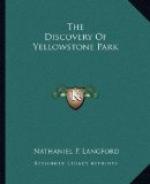On page 23 of this report Lieutenant Doane speaks of this mountain as “Mount Langford.” The map last published previous to that made by General Washburn was that of Captain Raynolds, of which I here present a copy, as well as a copy of the map made by me.]
[Footnote Q: On our return to Helena, Walter Trumbull published, in the Helena Gazette, some incidents of our trip, and from his narrative I copy the following account of our hunt for the grizzly:
“Some of the party who had gone a short distance ahead to find out the best course to take the next day, soon returned and reported a grizzly and her two cubs about a quarter of a mile from camp. Six of the party decorated themselves as walking armories, and at once started in pursuit. Each individual was sandwiched between two revolvers and a knife, was supported around the middle by a belt of cartridges, and carried in his hand a needle carbine. Each one was particularly anxious to be the first to catch the bear, and an exciting foot-race ensued until the party got within 300 yards of the place where the bear was supposed to be concealed. The foremost man then suddenly got out of breath, and, in fact, they all got out of breath. It was an epidemic. A halt was made, and the brute loudly dared to come out and show itself, while a spirited discussion took place as to what was best to do with the cubs. The location was a mountain side, thickly timbered with tall straight pines having no limbs within thirty feet of the ground. It was decided to advance more cautiously to avoid frightening the animal, and every tree which there was any chance of climbing was watched with religious care, in order to intercept her should she attempt to take refuge in its branches. An hour was passed in vain search for the sneaking beast, which had evidently taken to flight. Then this formidable war party returned to camp, having a big disgust at the cowardly conduct of the bear, but, as the darkie said, ’not having it bad.’ Just before getting in sight of camp, the six invincibles discharged their firearms simultaneously, in order to show those remaining behind just how they would have slaughtered the bear, but more particularly just how they did not. This was called the ‘Bear Camp.’”
Mr. Trumbull was one of the party of hunters whose efforts to capture the bear he so well describes.]
[Footnote R: Our subsequent journeying showed that Lieutenant Doane was right in his conjecture.]
[Footnote S: The Honorable Granville Stuart, of Montana, in his book “Montana as It Is,” published in 1865, says that there is another root found in portions of Montana which I have never seen. Mr. Stuart says:
“Thistle-root is the root of the common thistle, which is very abundant in the bottoms along nearly all the streams in the mountain. They grow to about the size of a large radish, and taste very much like turnips, and are good either raw or cooked with meat.”




